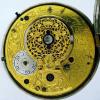Tap And Dies
-
Recently Browsing
- No registered users viewing this page.
-
Topics
-
Posts
-
Since I've learned lots here I thought I'd share a tip I picked up elsewhere and put to the test... For that 6105/6309 bezel lume pip look I've punched a clear plastic bottle of water, sanded it for the frost effect, removed the (smaller) pip from a standard/cheap replacement bezel, drilled it out to 2.5mm and fitted it using a smaller punch - fresh lume to hold into place. Pressing into place is a bit awkward but you soon get the hang of it, and the end result is pretty decent I'd say... The worst part probably being the drilling rather than the pip! It started out like this:
-
Ive asked this at a Seiko forum but I know there's plenty of experience here too... As I have it the recently discovered servicing technique on these is that you stuff the crown full of gaskets and work it until the recessed washer pops, remove the washer, switch the gasket out, dish the washer and push it back into place, levelling out the washer in the process? First attempt did not go to plan... I tried using a plastic pusher to manipulate the gaskets in the crown... Wasn't strong enough and I was struggling to even get the gaskets in up until it broke. Rethink consists of making/using actual tools: I don't have a staking set, so I've got the old man fashioning a metal pusher, essentially a 2.45mm OD tube with 1.6mm ID with a 6mm press the other end. Also got him on a dishing block/conical stake (sorry I'm terrible with terms) and a holder for the crown while I'm working on it... I figure that's enough to do the process described above? Push with the metal pusher, dish the washer with the conical stake, press back in with wider flat press (drilled centre so it doesn't catch on the tap). Plan is to stuff, press by hand and repeat? If that doesn't work by hand I've a drill press I could attach the pusher to for a little more leverage if needed. (Obviously I don't want to go too mad with that, and hopefully can avoid it altogether...) Sounds like a plan? I'd welcome any advice here, since I really don't want to wreck a crown. Having replaced all the other seals though id really like to sort these too. I welcome any input/advice from those who have been there and done it... Thanks!
-
You need to be more careful modifying the dial area. How does the bezel/lens fit on the front?



.thumb.jpg.19a9c4ff164d78d516aa9f05a063752b.jpg)


Recommended Posts